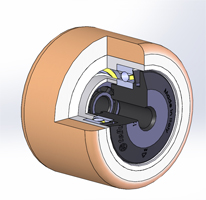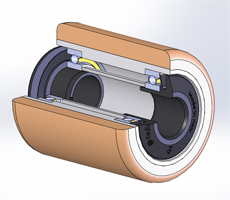18
Dec
Glossary: the anatomy of industrial wheels
Contents
Introduction
The basic elements of industrial wheels
The tread
The covering
The wheel core
The hub and swivel actions
The swivel bracket for industrial wheels
The wheel fork
The ball race ring
The swivel actions
The king pin
The dust seal
The fixed bracket on industrial wheels
The axle
Conclusions
Introduction
We often hear people talk about wheels, namely industrial wheels, but without having a perfect understanding of their basic characteristics. We therefore decided to provide a glossary (as complete as possible) for all the main wheel components suitable for various uses.
Let’s start with the basic definition, and then move on to the details: a wheel is a circular mechanical part that, by rotating around an axis, allows a sliding motion to be replaced with a rolling motion.
The basic elements of industrial wheels
The wheel is made up of the following basic elements: the tread, the covering, the wheel core, the hub and the swivel actions.

Figure 1: wheel core (1), hub (2), swivel action (3), covering (4), tread (5)
The tread
The tread forms the outer surface of the wheel, or rather the part that comes into contact with the ground. It can be smooth or engraved with patterns to improve its grip on the ground.
The covering
The covering, or rolling strip, constitutes the outer ring of the wheel, and is made from a different material.
The covering becomes fixed when it is joined to the wheel core (using an adhesive or a mechanical anchoring device), or else is mechanically keyed onto the wheel core.
The wheel core
The wheel core is the load bearing part of the wheel, which connects the covering to the hub. It’s made in various shapes and with different materials; it can consist of a single piece or two or more elements joined together.
The hub and swivel actions
The hub is the central part of the wheel designed to directly accommodate the axle or the swivel actions, which facilitate the wheel’s rotation (ball bearings, roller bearings, bushes, etc.).
There are four distinct families of industrial wheels, each of which has a different construction method and covering material: rubberised, polyurethane, monolithic and pneumatic. The bracket is the connecting element between the wheel and the trolley.
With the exception of wheels whose axles are built into the trolley itself, most types of wheels require the use of a bracket in order to be applied to the trolley.
The bracket can be of a swivel or fixed type.
Please note: The term “trolley” is meant to indicate any piece of equipment or machinery upon which the wheels and brackets are mounted in order to facilitate the handling of the trolley itself.
The swivel bracket for industrial wheels
Let’s start a new chapter and talk about the swivel bracket. This is an element that rotates on its own vertical axis as the direction of travel changes. The wheel axis is offset with respect to the axis of the bracket in order to provide the trolley with good manoeuvrability.
The term “manoeuvrability” means the trolley’s ability to change direction, while the term “directionality” means the trolley’s ability to maintain a set direction.
An excessive offset reduces the trolley’s directionality due to the “wavering” of the wheel (known as the “Swimmy” effect).
Depending on the type of attachment to the trolley, it is possible to have swivel brackets with plate, bolt hole, and stem.

Figure 2 - Bolt hole swivel bracket
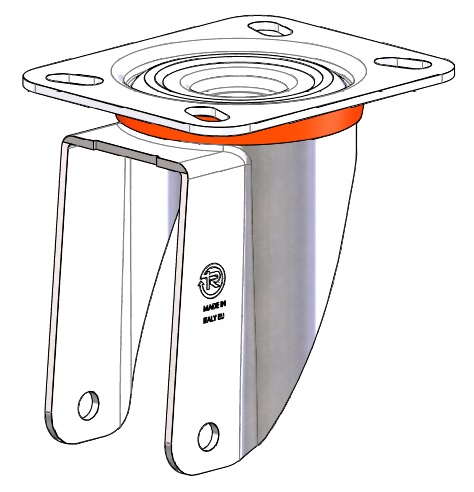
Figure 3 - Plate swivel bracket

Figure 4 - Smooth stem swivel bracket
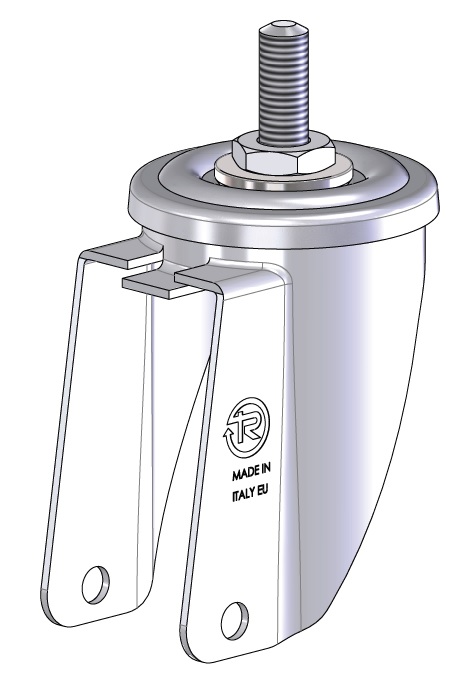
Figure 5 - Threaded stem swivel bracket
The stem swivel brackets can have stems of different types and sizes. The main types are the following: threaded stem, smooth stem and expansion stem, depending on the type of attachment to the trolley.
The swivel brackets can also be equipped with braking devices. The brake is a device that allows the user to block the rotation of the wheel alone, the rotation of the bracket alone, or the rotation of both the wheel and the bracket simultaneously.
The swivel bracket components are the following: the attachment plate, the fork, the ball race ring, the swivel actions, the king pin and, possibly, the dust seal.

Figure 6 - Swivel actions (1), attachment plate (2), dust seal (3), fork (4), ball race ring (5), king pin (6)
The attachment plate
The attachment plate is the trolley fastening element. It can be made in different shapes:
- Rectangular with four fastening holes;
- Square with four fastening holes;
- Triangular with three fastening holes;
- Circular with a bolt hole;
- Circular with a stem.
The wheel fork
The fork is the element with the characteristic inverted “U” shape that supports the wheel. The holes for housing the wheel’s axle are at the lower ends, and the swivel actions at the top.
The ball race ring
The ball race ring is the element that contains the bracket swivel actions. In some cases, it may only serve as a dust cover or protective device.
The swivel actions
The swivel actions allow the plate to rotate on the fork. They consist of radial ball bearings placed in contact between the plate and the fork, or else conical or axial ball bearings, properly lubricated with grease to protect against dust, liquids and other aggressive agents.
The swivel actions have a significant impact on the bracket load-bearing capacity.
The king pin
The king pin is the connecting element that joins the plate and the ball race ring to form a single piece, while the fork remains free to rotate on its own axis.
The stem can be:
- Built into the plate, obtained by pressing and riveting after assembling of the components;
- Built into the plate, obtained by hot pressing it on the plate and subsequently securing it with self-locking nut;
- Made up of a commercial bolt and nut.
The dust seal
The dust seal serves to protect the swivel bracket swivel actions. It protects the swivel actions against dust and solid aggressive agents.
The fixed bracket on industrial wheels
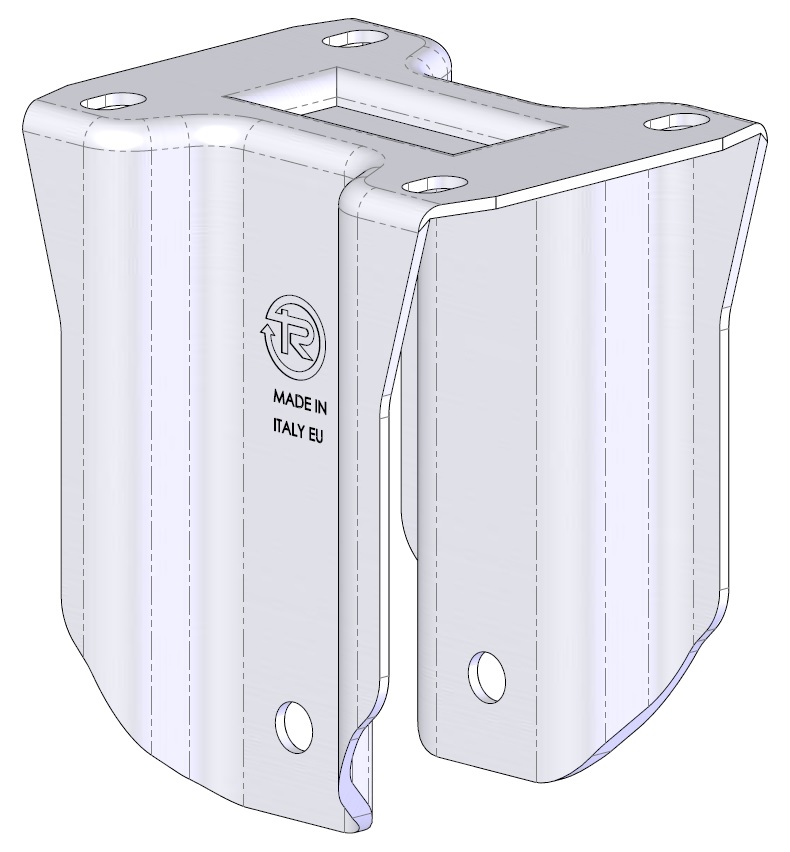
Figure 7 - Fixed bracket
Now we come to the fixed bracket, which serves to maintain the wheel facing a single direction, thus guaranteeing the trolley’s directionality, while the manoeuvrability depends on the use of swivel brackets. The fixed bracket generally consists of a single piece of steel sheet pressed to form an inverted “U” shape. The holes for housing the wheel axle are at the two lower ends, while the holes for fastening to the trolley are at the top.
The various combinations of fixed and swivel brackets underneath the trolleys are designed to facilitate handling in different industrial contexts, and will be discussed in greater detail in another section.
The axle
The axle is the connecting element through which the wheel is mounted onto the bracket. It normally consists of a threaded pin with a nut, washers, a bush and, where necessary, spacers.
For light duty applications, the axle can consist of a rivet riveted directly onto the wheel fork.
Conclusions
Knowing the individual parts of wheels and brackets, as well as their functions and the available variants, helps us better understand how they can be used in different domestic and professional contexts. The information above is naturally only intended to serve as a basic guide, but nevertheless provides the key elements to help you understand this important sector and make better informed choices.
Want to learn which types of industrial wheels are best suited to your specific needs, through a dedicated consultation? Contact our technicians to receive a no-obligation consultation for your specific project.



